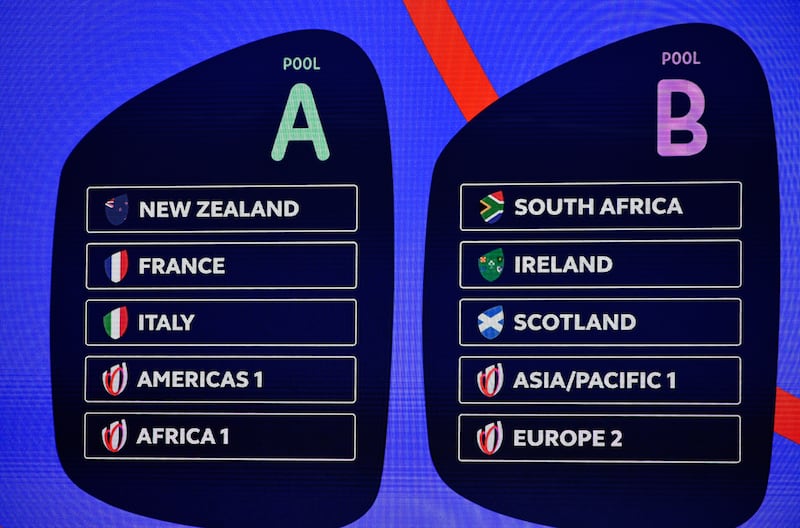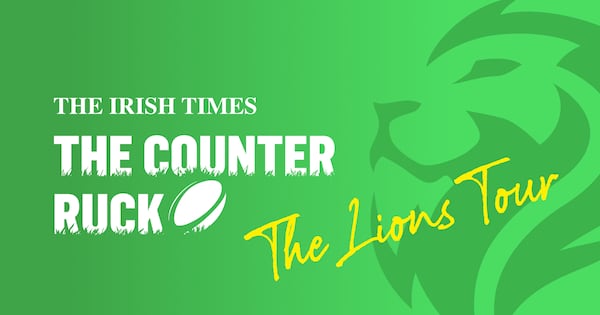Although we probably say it every four years, the 2023 Rugby World Cup really does look to be the most open and competitive of the 10 quadrennial tournaments so far, and that is in large part because it is the most ridiculously lopsided draw in history.
In other words, therefore, ridiculous and all as it may have been to hold the draw back in December 2020, one’s view of it being unfair probably depends on the country you support.
But whatever the viewpoint, this was an accident waiting to happen, and reflects poorly on World Rugby’s organisational skills.
The pool draw took place on December 14th, 2020, in Paris, exactly 1,000 days out before the opening game, to help the organisers plan ahead well in advance.
READ MORE
The seeding system from previous Rugby World Cups was retained with the 12 automatic qualifiers from 2019 being allocated to their respective bands based on their World Rugby rankings fully 11 months beforehand, ie January 1st, 2020.
Even in that timespan, the sands, and the rankings, had shifted. Back on January 1st, 2020, the top-four ranked teams were the Springboks, All Blacks, England and Wales (ie the 2019 World Cup semi-finalists). By December 14th, 2020, Wales had plummeted from fourth to ninth with France climbing from seventh to fourth, so why on earth use already out-of-date rankings?
By the end of the 2022 Six Nations, the top-four ranked teams were the Springboks, newly crowned Grand Slam winners France, the All Blacks and Ireland, and a year on they were still the top four, if in a different order.

Of course, all four will be in the same half of the draw at the 2023 World Cup, which means two of them will not progress past the quarter-finals. What’s more this has been compounded by Scotland, ranked fifth, being in the same pool as Ireland (ranked first) and South Africa (third) and thus the same half of the draw as well.
So, while three of the world’s top five sides won’t make the semi-finals, two of those countries ranked below them will reach the last four of the tournament.
For example, the highest ranked side in Pool C is Australia in eighth place, along with Fiji (ninth), Wales (10th), Georgia (11th) and the carefree Portuguese, who like to chuck it about, in 16th.
Opportunity also knocks in Pool D, in which England are the highest ranked, followed by Argentina (seventh), Samoa (12th), a free-falling Japan (14th) and Chile (22nd).
It makes you wonder why World Rugby bother having world rankings?
By contrast, the draw for the 2019 Rugby World Cup was made in May 2017, and thus based on seedings at that time, almost midway through that four-year cycle.
More damningly still for World Rugby, their footballing counterparts at FIFA conducted their draw for the 2022 World Cup on April 1st, 2022, in Doha, 235 days before the opening match. That was still time enough for the organisers of the world’s biggest sports tournament to plan where the teams would be based and for supporters to buy tickets.
World Rugby could have conducted the draw for the 2023 World Cup in December last year after the November Tests. True some teams’ form may still have fluctuated in the nine months before the World Cup, but nothing like to the extent that can happen over what is effectively a four-year period.
World Rugby chairman Bill Beaumont has explained the reasons the pool draws were made earlier “was because of the surety of the host cities and knowing where teams were going, which is very important”.
But he admitted: “What we will be doing is looking to have the pool draw as late as possible so that you get more consistency around the balance in a pool. There’s always going to be one pool which is tougher than the others.
“When we go to Australia [2027], we will be looking at how late we can make the pool draw.”
So, in that sense there’s not much point in being angry anymore. What’s done is done. The greatest Irish side ever to go to a World Cup has also been handed the toughest draw for any Irish side, largely down to World Rugby’s clunkiness, and quite possibly the same applies to Scotland. But it is what it is.
One’s view is also coloured by one’s allegiances, for if Ireland were in the position of either England or Wales, we’d be chuckling at the sense of opportunity.
England appear to be a mess, with not much in the way of joy, ambition or energy in their game. Both their captain, Owen Farrell unfairly pitched into the eye of a storm which was not entirely of his making, and Billy Vunipola, their sole number “8″ among 10 back five forwards in a 19-14 split (go figure) face disciplinary hearings which have cast a cloud over their pivotal opening game against Argentina.
Yet Steve Borthwick’s side are guaranteed not to face a side ranked higher than seventh before the semi-finals.
Likewise, Wales cannot face a side ranked higher than eighth before the semi-finals, which increases the possibility of Warren Gatland – a master at building teams at short notice – bringing them to the semi-finals for a third time in four attempts.
But whatever else, it certainly does make the pool stages interesting. It also opens up possibilities for Samoa and Fiji, who face Wales on the opening weekend in Bordeaux the day after Ireland kick off against Romania – on foot of having their hand strengthened by World Rugby’s changes to their eligibility laws.
Besides, there’s one undeniable truth. Joe Schmidt’s team underperformed at the last World Cup, as did Scotland, whereas England reached the final and Wales the semi-finals, and Ireland have certainly paid a price for that as a result.















